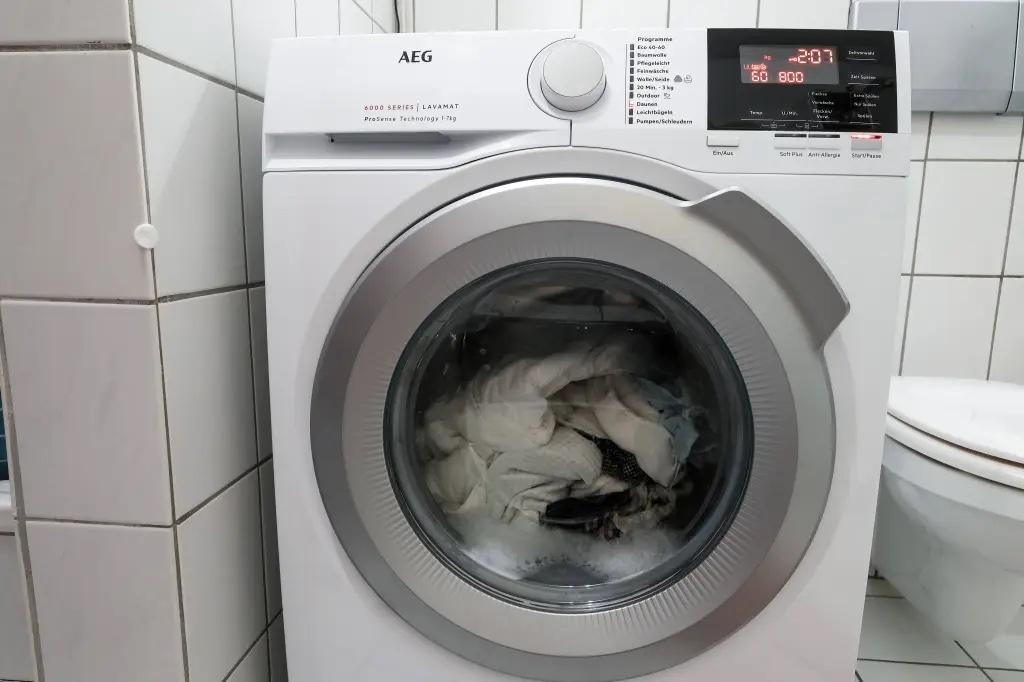Is your washing machine wandering during the spin cycle, shaking a lot or even jumping out of place? You should fix this problem as quickly as possible. In the worst case scenario, the appliance could disconnect from the water supply and cause water damage in your home.
Washing machine wanders during the spin cycle: 8 helpful tips
Here you will find possible causes of the washing machine moving during the spin cycle and find out how you can solve the problem in just a few simple steps. And don’t worry – the washing machine doesn’t necessarily have to be broken, the problem can also have completely different causes.
Removing the washing machine’s transport lock
Has your newly purchased washing machine started to move during the first wash cycle? Then the reason is usually the transport lock. It holds the free-swinging washing drum in place during transportation. If the transport lock of the washing machine is not released afterwards, the drum cannot swing freely during the spin cycle. To release the transport lock, you need to loosen four large screws on the back of the washing machine (six screws on a top loader). Modern models cannot be started at all with the transport lock tightened. With older models, however, it is worth checking this point.
Anti-vibration mats
Special rubber mats can absorb the vibration of the washing machine. Anti-vibration mats – also known as washing machine mats – are available at any DIY store.
Note: The higher the spin speed, the greater the risk of the washing machine jerking or wandering. Although a high speed ensures that the laundry is slightly drier, it does not ensure that it is also cleaner. For most washing cycles, a maximum speed of 800 revolutions is completely sufficient.
Optimal location
The washing machine often wobbles or wanders if it is not exactly level with the floor. As soon as the washing machine is tilted, the drum will also be tilted. In this case, try to adjust the support feet of the washing machine to the floor. Follow these steps to check whether the washing machine is level:
- Start a test spin cycle and place a pin on the washing machine. If the machine is tilted, the pin will always roll in the downward direction.
- As even small deviations cause the washing machine to move, you can use a spirit level for precise alignment or for checking.
Make sure the surface is clean
If the washing machine wanders, a dirty floor could also be the cause. If there is an anti-vibration mat on a greasy or dirty floor, the effect is even greater. Nobody cleans the floor under the washing machine after every wash cycle. After a few years, however, dust, dirt and moisture accumulate there. This can cause the washing machine feet to slip and the washing machine is then no longer perfectly aligned. It is therefore better to clean the floor under the washing machine at regular intervals.
You may also be interested in these articles:
Loading the washing machine evenly
Unevenly loaded or overloaded washing machines are more likely to move during the spin cycle. Every washing machine has information on the maximum load volume. This makes it easier for you to estimate how much laundry you can wash at once. Also make sure to mix large items (e.g. sheets) with smaller items of clothing (e.g. socks and shirts).
Is the drum broken?
You cannot tell from the outside whether the washing drum is defective. Therefore, start a test run and let the washing machine spin at 600 to 800 revolutions without any load. If the washing machine moves at this low speed, the drum could actually be defective.

Defective shock absorber
Over time, the drum’s shock absorbers can wear out. The washing drum itself also suffers from this and an imbalance may occur. This means that the drum deflects too much in one direction during the spin cycle. In the long term, this will cause the washing machine to break down.
Check the drain pump and lint filter
If the drain pump is not working properly, excess water will remain in the washing machine. The extra weight could also cause an imbalance during the spin cycle. Before you call a technician, you should first clean the drain pump and the lint filter attached to it. Both parts are hidden behind a small flap in the lower section at the front of the washing machine. You should have a bowl and some kitchen towels ready to catch any waste water.
If you have checked all possible triggers and still haven’t found the fault, it’s high time to contact a technician or think about buying a new washing machine.
Source: t-online
Thumbnail: ©Flickr/Hannah and Simon ©IMAGO / Michael Gstettenbauer
